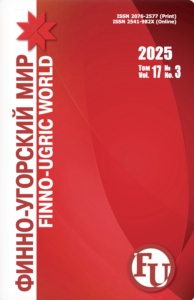Tambi Sergei A.,
Graduate student (MA), Moscow State Institute of International Relations (University) of the Ministry of Foreign Affairs of the Russian Federation (Moscow, Russia), sergey.tambi@gmail.com
Introduction. The Luga direction was one of the main migration routes for the Estonian population from the Estland province to the east. Here, many Estonians (with their children, grandchildren and great-grandchildren) have found a home for many years. The distinctiveness and identity of the Eastern Estonians (in Estonian “idakandieestlased”, or “ida-estlased”), including Luga ones, is a kind of phenomenon that can be found in Russia as well. The descendants of the resettled Estonians have always maintained close ties with Estonia. The subject of the study is Luga Estonians as an ethnic group of Estonians who migrated on the territory of Luga district in the 19th–20th centuries; the object is the study of their identity. The aim of the research is to study the history and current status of this ethnic group. To achieve the goal, it considers a set of reasons for the resettlement of Estonians from Estonia to the east, namely to Luga district; determines the stages of resettlement of peasants; establish a list of places of compact residence of Estonians in the XIX–XX centuries; studies religious features of the population; discusses churches and parishes of the district that the Estonians attended; shows cultural features of the life of local Estonian community in Luga district of the St. Petersburg area; identifies traditions, including songs; tells about the famous Estonians, the natives of the district; analyzes current situation of the ethnic group in Luga district of the Leningrad region; identifies some toponymic names of the Luga region, which occur, according to one version, from the Estonian language. The practical significance of the work is indisputable, since the Estonians contributed to the history of the multinational Luga region, which until now has not been considered deeply by either national or international researchers. The main and in fact the only study of this community is the article by M. L. Zasetskaya, and there is no other literature on the subject.
Materials and Methods. The main methods used in the study were the generalization method, the system approach, the historical-descriptive method, analysis of the documents, and the empirical descriptive method. Numerous articles and notes from Estonian newspapers, as well as materials from Estonian archives were used to reconstruct the features of the life of Luga Estonians.
Results and Discussion. It shows the dynamics of the change of Estonian population in Luga region, which demonstrates its significant increase in the 1920s – the first half of the 1930s. (during the Soviet ‘localization policy’); the drop, starting from the second half of the 1930s, and also after the Great Patriotic War of 1941–1945 (due to Stalin repressions of 1937–1938 and assimilation).
Conclusion. The phenomenon of Luga Estonians is unique and interesting for research. They made an invaluable contribution to the history and culture of multinational Luga region.
Key words: Luga Estonians; Estonia; Luga; Luga County; Luga region; Leningrad region; Eestlased Luuga rajoonis.
For citation: Tambi SA. Luzhskie estontsy [Luga Estonians]. Finno-ugorskii mir = Finno-Ugric World. 2017; 2: 85–92. (In Russian)
1. Vykhma Avgust Ivanovich. Vozvrashchennye imena. Knigi pamiati Rossii. Rossiiskaia natsional’naia biblioteka [Vykhma Avgust Ivanovich. The returned names. Memorial Book of Russia. Russian National Library]. Available from: http://visz.nlr.ru/person/show/1542680 (accessed 01.02.2017). (In Russian)
2. Viatson Avgust Petrovich. Vozvrashchennye imena. Knigi pamiati Rossii. Rossiiskaia natsional’naia biblioteka [Viatson Avgust Petrovich. The returned names. Memorial Book of Russia. Russian National Library]. Available from: http://visz.nlr.ru/person/show/1542687 (accessed 01.02.2017). (In Russian)
3. Zasetskaia ML. Estontsy Luzhskogo raiona Leningradskoi oblasti (konets XIX – seredina XX veka) [Estonians of the Leningrad Oblast’s Luga district (the end of the XIX – the middle of the XX century)]. Naselenie Leningradskoj oblasti: materialy i issledovanija po istorii i tradicionnoj kul’ture = The population of the Leningrad Oblast: materials and research on the history and traditional culture. Sankt-Peterburg; 1992: 132–143. (In Russian)
4. Zertsalov VI. Luga: putevoditel’ [Luga: guidebook]. Leningrad; 1972. (In Russian)
5. Klimberg Ferdinand Karlovich. Vozvrashchennye imena. Knigi pamiati Rossii. Rossiiskaia natsional’naia biblioteka [Klimberg Ferdinand Karlovich. The returned names. Memorial Book of Russia. Russian National Library]. Available from: http://visz.nlr.ru/person/show/1543656 (accessed 01.02.2017). (In Russian)
6. Luts Vasilii Mikhailovich. Vozvrashchennye imena. Knigi pamiati Rossii. Rossiiskaia natsional’naia biblioteka [Luts Vasilii Mikhailovich. The returned names. Memorial Book of Russia. Russian National Library]. Available from: http://visz.nlr.ru/person/show/1539414 (accessed 01.02.2017). (In Russian)
7. Nabokina OV, Noskov AV. Luga i okrestnosti: iz istorii naselennykh mest Luzhskogo raiona [Luga town and the neighborhood: from the history of the localities of the Luga district]. Moskva; Sankt-Peterburg; 2014. (In Russian)
8. Rossiiskii gosudarstvennyi istoricheskii arkhiv [Russian State Historical Archive]. F. 1288. Op. 25. D. 48. L. 16 ob., 21 ob., 23 ob. (In Russian)
9. Tsentral’nyi gosudarstvennyi arkhiv istoriko-politicheskikh dokumentov Sankt-Peterburga [Central State Archive of Historical and Political Documents of Saint Petersburg]. F. 16. Op. 12. D. 12343. L. 1, 5, 7, 9. (In Russian)
10. Estonskii prikhod pri Ekaterininskom sobore [Estonian parish at St. Catherine’s Cathedral]. Available from: http://www.petergen.com/bovkalo/kl/spblugaekatest.html. (In Russian)
11. ERAF. Andmed Eesti asunduste kohta Nõukogude Liidus. 25.1.114; 1926. L. 18–21. (In Estonian)
12. ERAF. Eestlaste kolhooside nimekiri. 62.1.164; 1937. L. 1–13. (In Estonian)
13. ERAF. Luga rajoon. 62.1.67; 25.01.1933–13.10.1935. L. 5, 49, 54, 61, 64, 75. (In Estonian)
14. ERAF. Luga rajoon. 62.1.68; 31.05.1935–19.10.1936. L. 19. (In Estonian)
15. ERAF. Luga (Luuga) rajoon (Leningradi oblast). 62.1.30; 09.08.1937–03.11.1937. L. 1. (In Estonian)
16. Laasik H. Eestlased Luuga rajoonis. 02.04.2013. Vooremaa. Available from: http://www.vooremaa.ee/eestlased-luuga-rajoonis (külastatud 01.02.2017). (In Estonian)
17. Luuga eesti kirik kultuurimajaks. Edasi. Jaanuar 1930; 5. (In Estonian)
18. Luuga Eesti klubi. Edasi. Juuni 1922; 121. (In Estonian)
19. Luuga Eesti klubis. Edasi. Juuni 1922; 127. (In Estonian)
20. Luuga Eesti poliitklubi elust. Edasi. Detsember 1923; 288. (In Estonian)
21. Luuga kreisi Eesti koolidele. Edasi. September 1927; 77. (In Estonian)
22. Luuga ringkonna eestlastele. Edasi. Juuni 1928; 43. (In Estonian)
23. Nigol A. Eesti asundused ja asupaigad Venemaal. Tartu; 1918. (In Estonian)






















